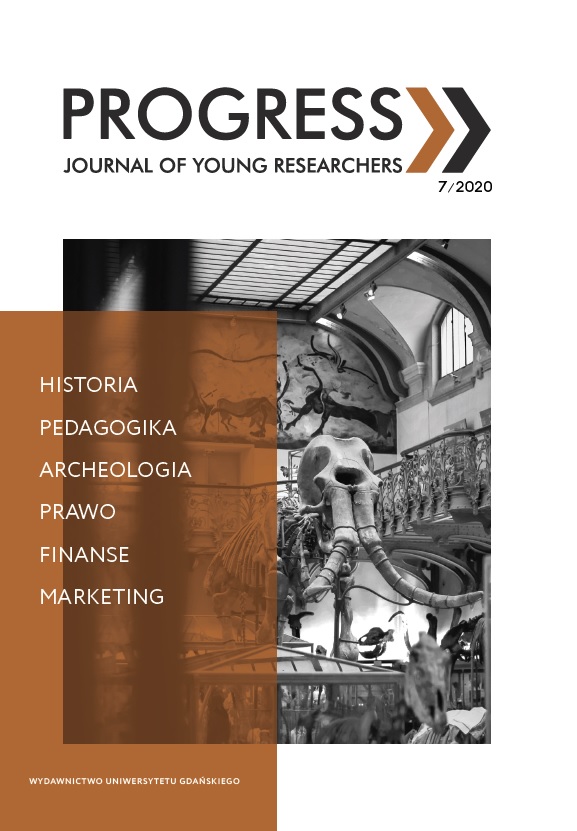Czy artysta może być filozofem? Twórczość Leonarda da Vinci w kontekście myśli i filozofii renesansu
DOI:
https://doi.org/10.26881/prog.2020.7.07Słowa kluczowe:
filozofia, renesans, Leonardo da Vinci, estetyka, humanizmAbstrakt
Celem artykułu jest wykazanie, że artysta może być filozofem. Autorka tekstu posłużyła się przykładem Leonarda da Vinci, w kontekście epoki, w której żył i tworzył. Pierwsza część pracy dotyczy najważniejszych cech renesansowej filozofii oraz ich krótkiego omówienia. Wyróżnione zostały: humanizm, naturalny system kultury, zainteresowanie filozofią przyrody oraz odrzucenie scholastyki. Dodatkowo podkreślono charakterystyczne dla tej epoki przekonanie o wielkości i nowatorstwie swoich czasów oraz antropocentryzmie. Kolejna traktuje o związkach między filozofią, sztuką (w szczególności malarstwem) oraz nauką. W epoce odrodzenia dziedziny te były ściśle ze sobą powiązane. Najszerszym pojęciem jest filozofia, która zawiera w sobie i sztukę, i naukę. W sztuce oraz nauce można dostrzec korelacje, które sprzyjaja ich wzajemnemu rozwojowi. Ostatnia część artykułu stanowi podsumowanie poprzednich akapitów oraz zestawienie ich z dziełem Leonarda da Vinci Traktatem o malarstwie. W tekście tym możemy odnależć mnóstwo śladów i odniesień do ówczesnej filozofii. Sam da Vinci w jednym z pierwszych paragrafów swojego traktatu zrównuje malarstwo z filozofią, a te z nauką, co pozwala nam sądzić, że sam siebie postrzegał nie tylko jako artystę, ale równiez naukowca i filozofa.
Downloads
Bibliografia
Alberti L., 1963, O malarstwie, tłum. L. Winniczuk, Warszawa.
Burckhardt J., 1965, Kultura odrodzenia we Włoszech, tłum. M. Kreczowska, Warszawa.
Ciszewski M., Renesansu filozofia, Powszechna Encyklopedia Filozoficzna, http://www.ptta.pl/pef/pdf/r/renesansuf.pdf [dostęp: 29.04.2019].
Crombie A., 1960, Nauka średniowieczna i początki nauki nowożytnej, t. 2, tłum. S. Łypacewicz, Warszawa.
Drozdowicz Z., 2012, Filozofia włoska w epoce Odrodzenia i Oświecenia, Poznań.
Ganowicz-Bączyk A., 2011, Wpływ nowożytnego antropocentryzmu na relacje człowieka do przyrody, „Studia Ecologiae et Bioethicae”, nr 1, z. 9.
Hojnacki P., 1957, Filozofia nauki przyrodniczej w okresie odrodzenia, „Collectanea Theologica”, nr 28, z. 3.
Konik R., 2013, Między przedmiotem a przedstawieniem. Filozoficzna analiza sposobów obrazowania w oparciu o malarstwo i obrazy syntetyczne, Wrocław.
Kristeller P., 1982, Humanizm i scholastycyzm we włoskim renesansie, tłum. G. Cendrowska, „Pamiętnik Literacki”, nr 73.
Kuczyńska A., 1984, Sztuka jako filozofia w kulturze renesansu włoskiego, Warszawa.
Leonardo da Vinci, 1984, Traktat o malarstwie, tłum. M. Rzepińska [w:] M. Rzepińska, Leonarda da Vinci „Traktat o malarstwie”, Wrocław.
Pliniusz, 1961, Historia naturalna, tłum. I. i T. Zawadzcy, Wrocław.
Rzepińska M., 1984, Leonarda da Vinci „Traktat o malarstwie”, Wrocław.
Tarnowski J., 2015, Wieża Babel dyskursu nowoczesności. Zamiast wstępu [w:] J. Bielak, J. Tarnowski (red.), Nowoczesność w sztuce i w myśli o sztuce na pomorzu od XIX do XXI w., Gdańsk.
Tatarkiewicz W., 1967, Estetyka nowożytna, Zakład Narodowy im. Ossolińskich, Wrocław.
Trzcińska I., 2015, O epoce renesansu w perspektywie filozofii kultury [w:] P. Mróz (red.), Filozofia kultury, Kraków.
Ullmann E., 1984, Leonardo da Vinci, tłum. A. Konopacka, Warszawa.
Warburg A., 2010, Narodziny Wenus i inne szkice renesansowe, tłum. R. Kasperowicz, Gdańsk.
Wilczek P., 2005, Literatura polskiego renesansu, Katowice.
Włodarczyk A., 2014, Etyka interpretacji tekstu literackiego. Postmodernizm. Humanizm. Dydaktyka, Kraków.
Wojtysiak J., Zasada, https://www.kul.pl/les/57/encyklopedia/wojtysiak_zasada.pdf [dostęp: 11.11.2019].
Pobrania
Opublikowane
Jak cytować
Numer
Dział
Licencja
Prawa autorskie (c) 2020 Author(s)

Utwór dostępny jest na licencji Creative Commons Uznanie autorstwa 4.0 Międzynarodowe.

 Uniwersyteckie Czasopisma Naukowe
Uniwersyteckie Czasopisma Naukowe




